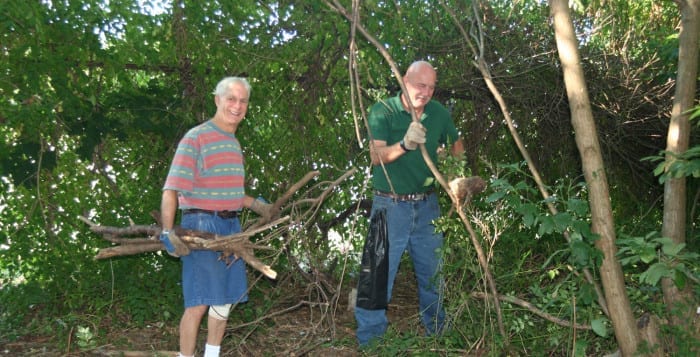By Melissa Arnold
Some people say they see the world through rose-colored glasses. Contemporary artist Christopher Reisman sees the world in technicolor.

His acrylic and mixed-media paintings mostly showcase people and animals with a whimsical, kaleidoscope-like color palette. Some of his paintings are abstract, but for the Rocky Point resident, it’s all about experimentation and play.
A selection of his abstracts and animal portraits will be on display throughout the month of September in an exhibit titled “Paintings by Christopher: All Things Sacred” at the North Shore Public Library in Shoreham. The art show will feature paintings, some as large as 48 inches wide by 60 inches high, and several prints.
This is Reisman’s second appearance at the library, says art coordinator Hildegard Kroeger. He had an exhibit there six years ago. “He’s doing a lot more freestyle work now,” Kroeger says. “He’s very colorful and people really pay attention to his work when they stop by.”
Reisman’s talents — which also include sculpture, music and sewing — are more than just hobbies. They have been his lifeblood since he was a toddler.
“I drew on the walls as a child and was always getting big pads of drawing paper from my parents, who were very encouraging,” says Reisman.
His creative streak would lead to an art-intensive high school education and some study at what is now Temple University’s Tyler School of Art, but Reisman’s mostly self-taught. He spent more than 40 years as an art educator in a variety of settings before an illness led him to retire in 2000.

Since then, Reisman has been able to focus fully on enjoying and sharing his gifts, which have healed him inside and out. “Even in the darkest times in my life — and I’ve been through plenty, trust me — I was drawing and playing the piano,” Reisman explains. “[Through my illness and later recovery] I’ve learned that we need to learn to let go — whether that’s of a bad habit or an old way of thinking — and if we can do that, we can come to a place of healing. I hope to reach as many people as possible with that.”
Today, Reisman enjoys long hours painting at his home, which he calls the “sanctuary.” The property, which he shares with his partner Robert McDonald and their two cats, Dolly and Joey, is also home to hundreds of birds, fish and other animals.
The artwork he creates is for more than display. Anywhere from 10 percent to the full value of each sold painting supports charitable interests close to his heart.
Reisman and McDonald have worked together to support a number of animal shelters on Long Island, including SAVES, Inc. (Spay Alter Vaccinate Every Stray) of Riverhead, Little Shelter Animal Rescue & Adoption Center in Huntington and Save-A-Pet Animal Rescue & Adoption in Port Jefferson Station, among others.
They are also big supporters of the global Wildlife Conservation Society, Broadway Cares/Equity Fights AIDS, and many cancer benefits that cross their path.
McDonald, who does not have an art background, loves to sit back and watch Reisman’s creative process, which usually begins with several days of research, drafting and prayer.
“It’s like miracle work to me, that [Christopher] can start with a blank canvas and in the course of a few hours or a day have it completely drawn out and ready to be painted,” says McDonald, who has been with Reisman for 16 years. “He’ll say to me, ‘Today I’m going to paint a tiger,’ and the next day it appears. I would never be able to do something like what he does.”

Some paintings have specific stories — like his chimpanzees,“The Visit,” inspired by the work of famed primatologist Jane Goodall, or his self-portrait, “The Joy Keeper,” painted at home in his hall of mirrors over an old abstract painting ‘to show the joy we can all feel if we allow it’ — but others are just subjects Reisman or his family members enjoy.
For abstract pieces, Reisman says that he likes “staying spontaneous and moving color around that excites me, without judging.”
The couple believes that sharing their gifts, both physical and emotional, is just the first step toward a healthier, more peaceful world. They are currently searching for a publisher to get the art to a wider audience.
Reisman has gained many fans through the years and has received rave reviews from his past art exhibits. Newsday art critic Jeanne Paris wrote that his artwork projects “unspoken eloquence in visual imagery that is not to be forgotten,” and “I Had It All the Time” author Alan Cohen stated “Christopher Reisman creates with passion, power and purpose. His heart is in his art. If you look deeply you will see much.” Even “Good Day New York’s” Rosanna Scotto has purchased one of his paintings.
“When people see my work, they’ll see lots of bright, happy colors and find they feel a joy and peacefulness that’s very powerful,” Reisman explains. “I believe that power comes from within each of us. It’s been my mission to turn as many people as possible onto their own innate creativity. I find that it’s very healing.”
Explore some of Christopher Reisman’s artwork from Sept. 1 through Sept. 29 at the North Shore Public Library, 250 Route 25A, Shoreham.
An artist reception, hosted by the Friends of the Library, featuring a larger selection of Reisman’s art, will be held on Saturday, Sept. 12, from 2:30 to 4 p.m. at the library. All are welcome.
For more information about the exhibit, call 631-929-4488. To learn more about Reisman or to purchase his art, visit www.artbychristopher.org.












